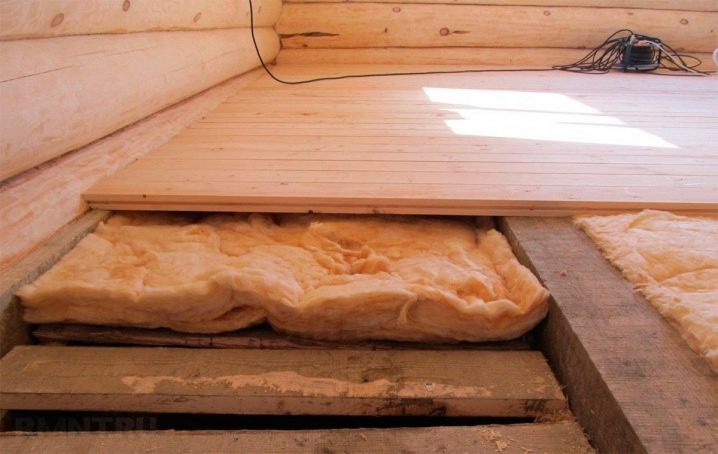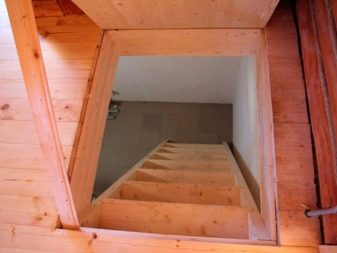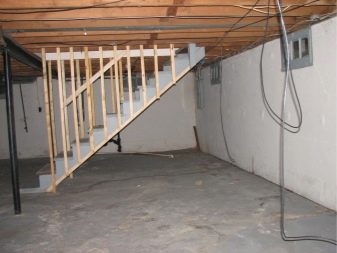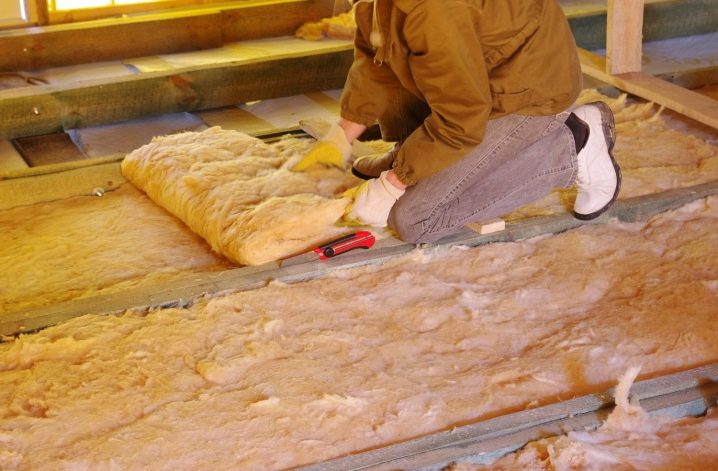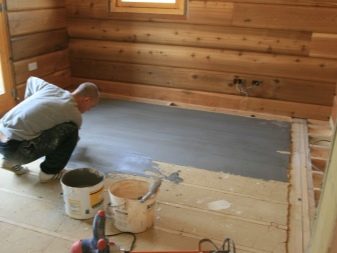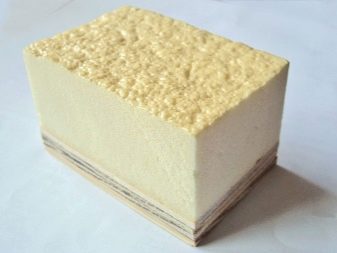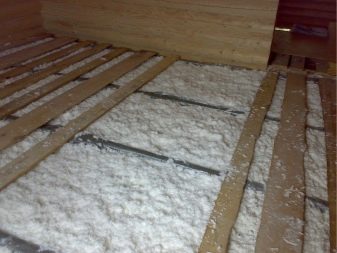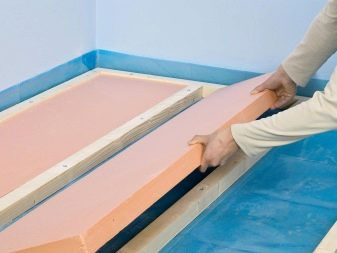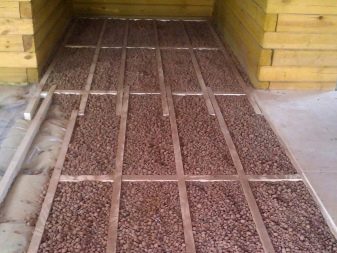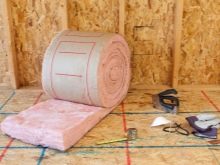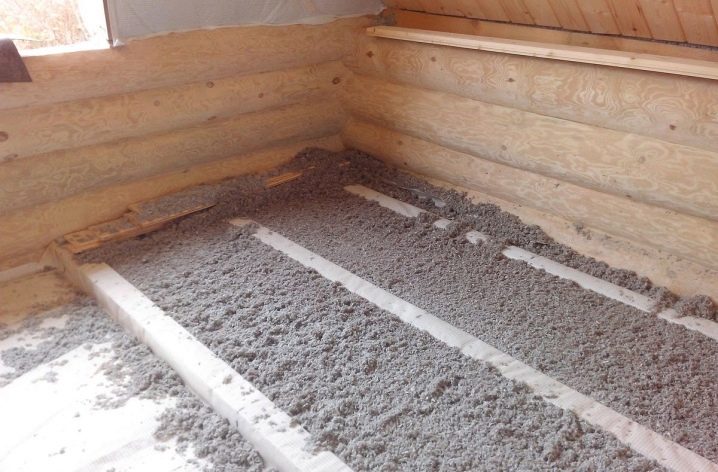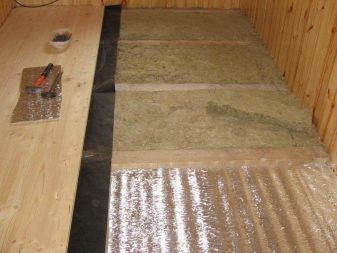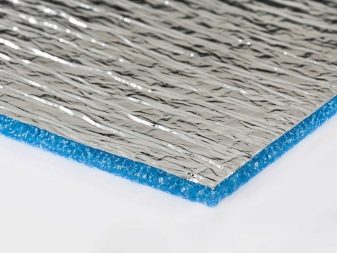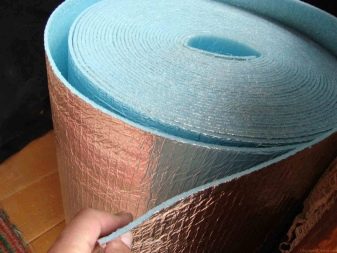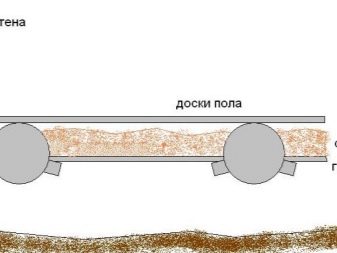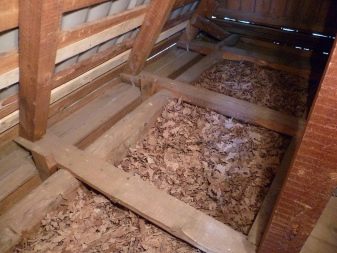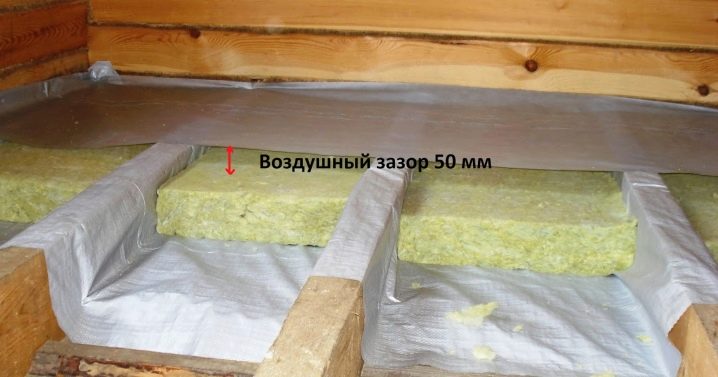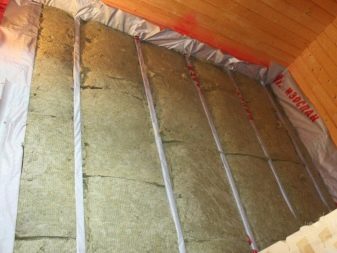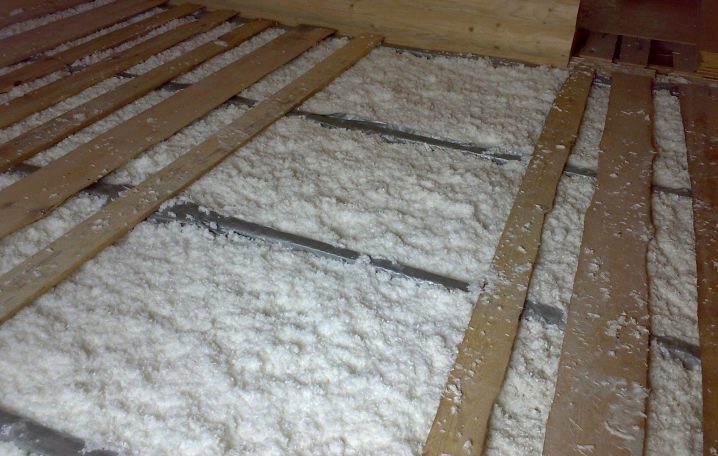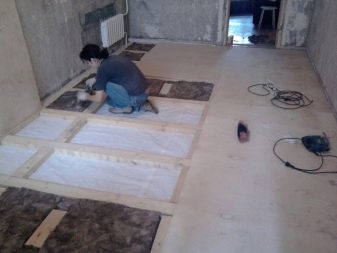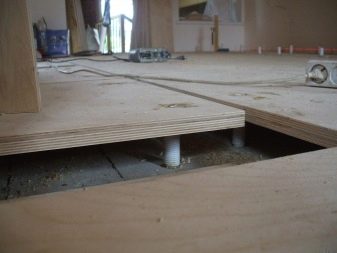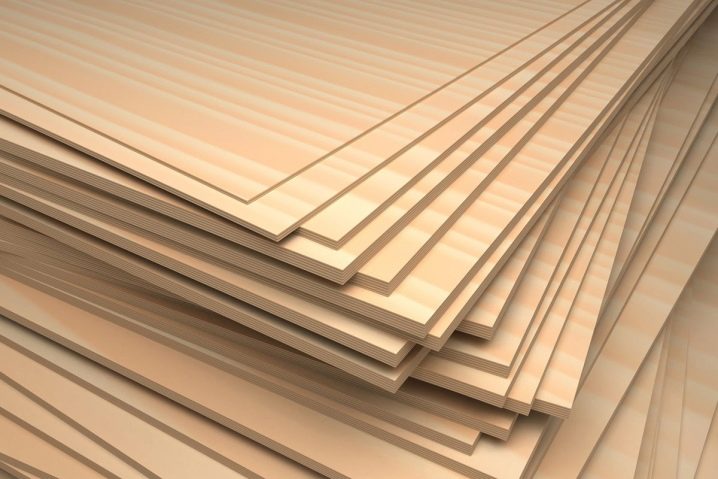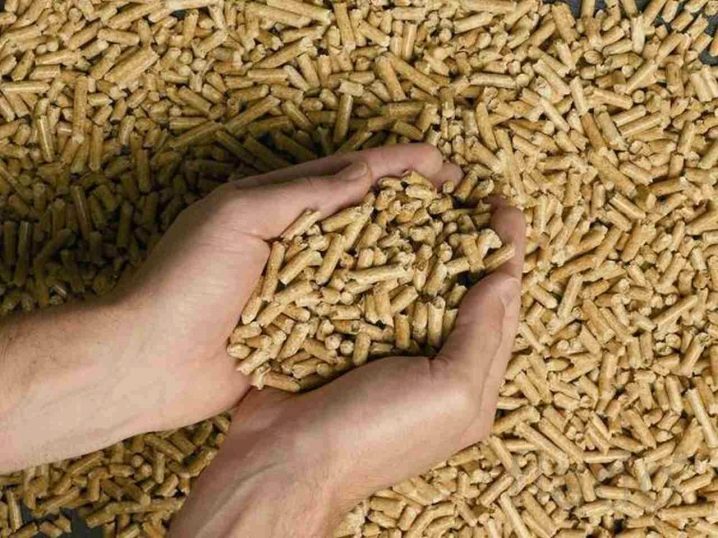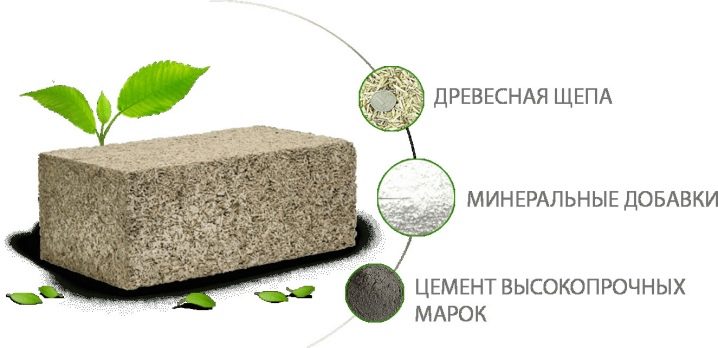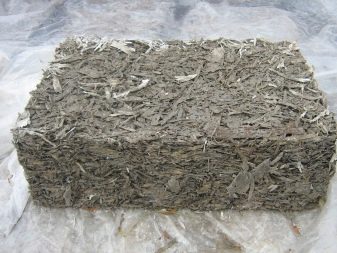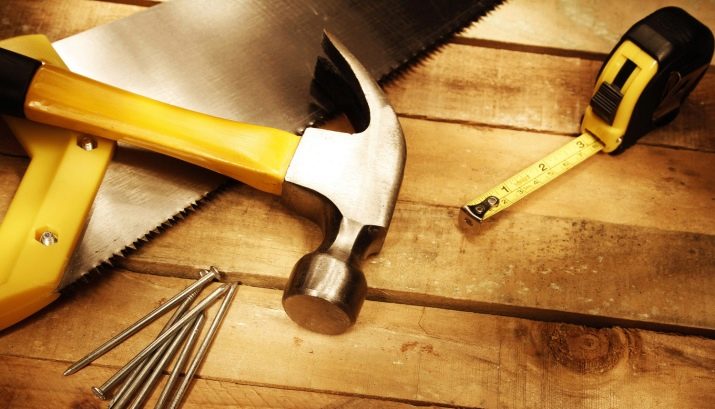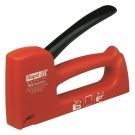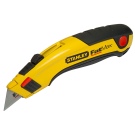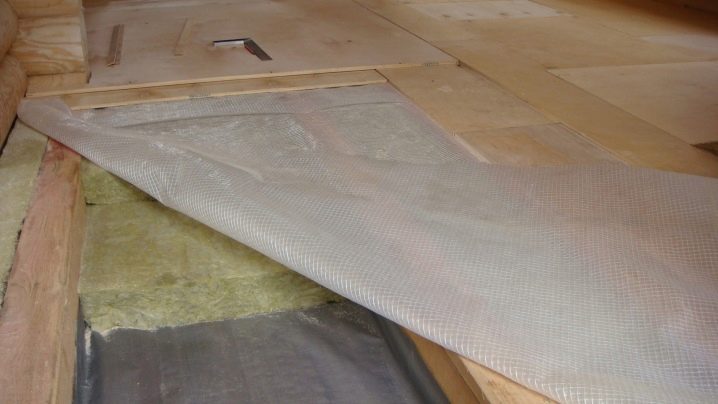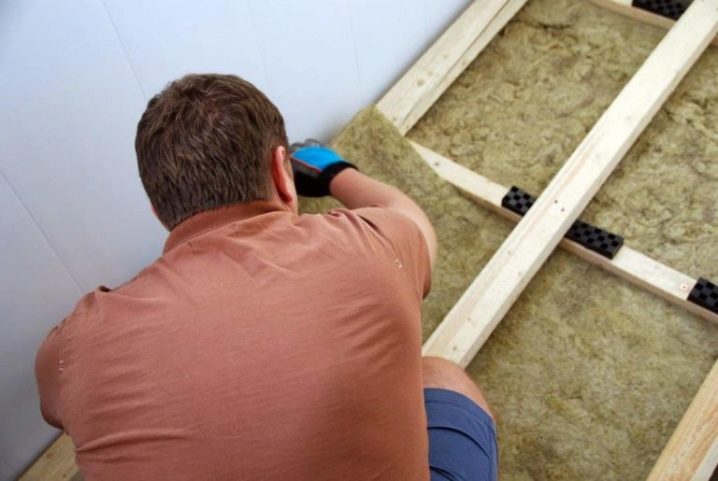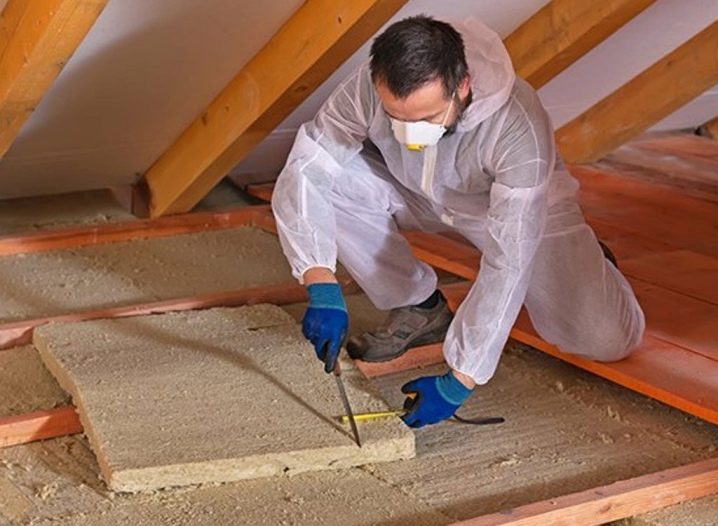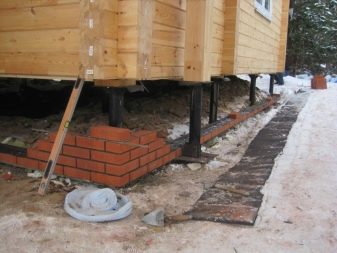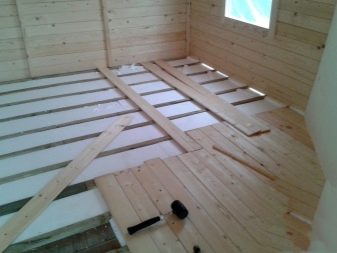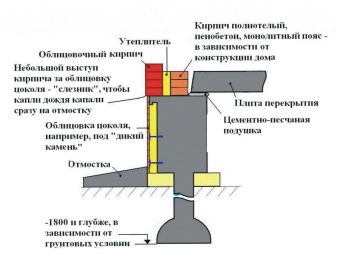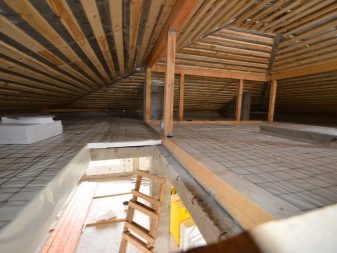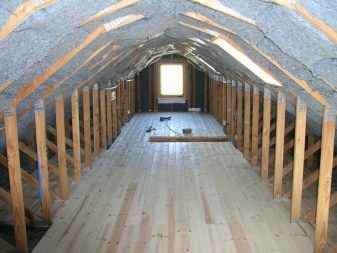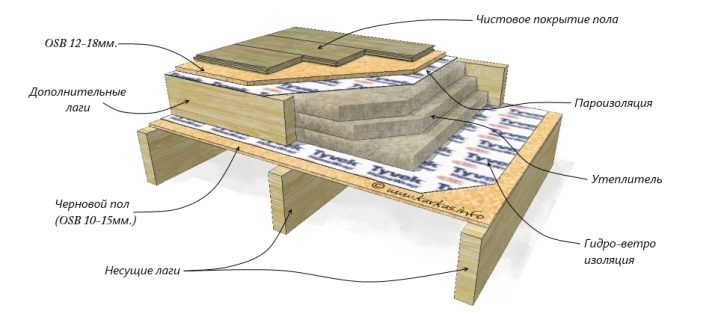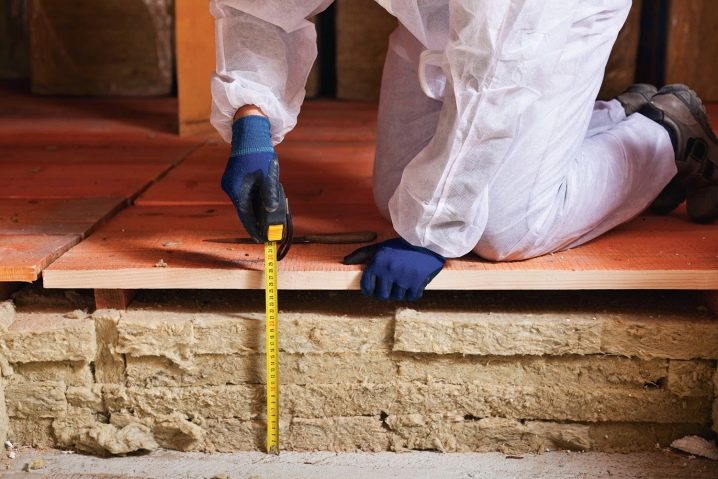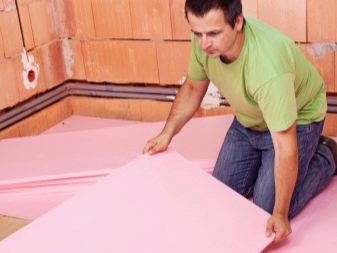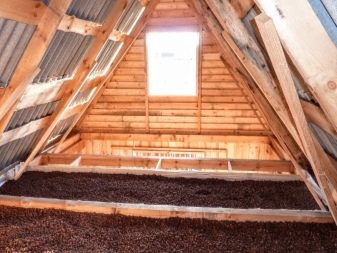Warming the floor in a wooden house with their own hands
When constructing private homes, many features should be taken into account that can have a decisive effect on the feeling of comfort and warmth. Therefore, it is important to take care of warming not only walls, doors and windows. Preservation of heat in the house depends not only on the quality of heating. Warming the floor in a wooden house with your own hands is a necessary stage in the construction of your own dwelling, if we are talking about a place where you can live without fear of the cold. Fortunately, the modern market and the ingenuity of the masters offer many options that you can always use.
Features and benefits
If there is an underground or a basement in a wooden house, the warming process must be started from there: as a result of the cold air that comes from the freezing ground, a large loss of heat is formed.Also, before warming, it is necessary to ensure total drying of the entire room where the work will be carried out using special instruments for ventilation.
After that, pre-tamping of the soil and sprinkling it with sand is carried out, the layer of which must be at least 15-20 centimeters in thickness.
The very installation of thermal insulation coatings is not particularly difficult. The main thing is that the materials are of good quality with special treatment: this will help reduce the impact of the severity of the boards, the soil and low temperatures on them. Before you buy a warming coating, you should consider what the load on them will be, as well as the level of the lowest temperature index that can adequately withstand this or that type of material.
It is also important where the insulation will be laid, since, depending on the place in the house, one method of work will be different from another.
But in general, any insulation technology has several main stages:
- At first, logs are mounted, then dense sheets of wood are fixed on them and only after that the laying of the insulation itself begins.
- After the insulation has been laid, the base is sheathed with a material that has the property of insulation from steam and moisture: this ensures that the material will retain its original properties longer.
- In conclusion, the draft foundation is refined with the help of finishing.
Materials
Whatever the insulation for the floor, the materials must have sound and heat insulating properties in order to keep the house warm and feet as comfortable as possible. The stability of the insulation to fire in case of smoke or fire in the room is desirable. Of course, the insulation should not have a high absorption of moisture: in this case, it very quickly loses all of its necessary qualities and does not fulfill the main purpose. The environmental friendliness and safety of the material, its durability and resistance to damage of various kinds are also welcomed.
There are a lot of material options for floor insulation in wooden houses: among them you can choose the one that suits every customer, including the price.
Polyurethane foam
It is possible to warm wooden floors with polyurethane foam.This material has a cellular structure, weighs quite a bit, but at the same time retains heat well. Fungi and mold rarely appear in it, it does not rot and is resistant even to chemical compounds, for example, to acids.
The application of polyurethane is carried out by a special technique, it has high adhesion characteristics with surfaces.
The undoubted plus of it is that they can carry out the insulation of any floor, while there will be no joints.
Extruded polystyrene foam
Extruded polystyrene foam (EPS) or just foam is cheap, does not release heat to the outside, fireproof, resistant to chemicals and serves while fully maintaining all of its performance characteristics for a long time.
However, the foam has one significant disadvantage - it can absorb liquid, especially if it is used in rooms with a high degree of humidity.
When choosing a material, this feature should be taken into account and foam should be used to warm the floor where it is as warm and dry as possible.
Penoplex
Penoplex is a light polymer having a homogeneous structure, which greatly facilitates its use and work with it. It is good because it does not overload the base of the house.This material is produced using extrusion technology, when raw materials melted under the influence of high temperatures are forced through a certain form, which is called an extruder.
For this reason, penoplex has a high degree of wear resistance and resistance to a wide range of temperatures - from high to very low. In addition, it almost does not absorb moisture, which allows them to warm places with high humidity.
Expanded clay
Expanded clay - a granular substance of a porous nature. It is made in the form of small round-shaped balls, and the basis of its production is the burning of shale or clay rocks in furnaces. This material, having only natural origin, has a high degree of environmental friendliness and durability. It is also frost-resistant and especially resistant to fire.
Its disadvantage is that it becomes more dense over time due to its weight, as a result of which its thermal insulation performance may decrease.
Minwat
Minvatoy (or rokvul) also often insulate wood flooring. Mineral wool is produced either in the form of mats with an elastic structure, or in the form of high-strength panels.The method of laying such a material is one layer, which is very convenient in working with it.
Minvat is wear-resistant, almost does not let moisture, is environmentally safe and resistant to mechanical damage. According to customer reviews, mineral wool is one of the most sought-after, high-quality and inexpensive heaters that are used most often.
One of the most famous companies producing high-quality insulation in the form of environmentally friendly mineral wool is Rokvul. This company has long established itself as the best manufacturer of insulation.
Ecowool
Ecowool has good thermal insulation properties. It consists of mineral additives and cellulose, which ensures its environmental friendliness and safety for human health. It is inexpensive, but nevertheless impregnated with boric acid, which makes it resistant to moisture and mold.
Ecowool insulation is very effective, it perfectly retains heat and is particularly resistant to fire.
Izolon
A foil isolon is similar in appearance to a shiny foil. Specially processed dense foil of polyethylene, which was foamed during processing, is on top, and below is a porous lightweight material.It is used as insulation not so long ago, so it has not yet gained wide popularity among buyers.
It is environmentally safe and, despite the small thickness (maximum ten millimeters), perfectly retains heat and is particularly resistant to moisture. Especially convenient is its form of release in the form of rolls, which greatly facilitates the work with this material during its installation with your own hands.
When laying izolona it should be laid only overlapped, so as not to lose heat, and the resulting seams should be treated with adhesive for polymers or mastic for bitumen.
Penofol
It is possible to warm a wooden floor with penofol, which has been produced quite recently. The bottom line is that the reflective layer, which has this material, retains heat and prevents the scattering of light.
Penofol is available in rolls, which facilitates its use, and most often work with it when you need to warm the floor between floors. It is resistant to heavy loads and does not require a vapor barrier layer, and the technique of its installation is the same as when working with an isolon.
Sawdust
Warming of sawdust is one of the easiest ways to preserve the heat of a wooden floor.Sawdust is environmentally friendly. This material is quite light, so it can be used not only for warming floors, but also for coatings between floors. Since this is a granular material, its layer thickness is easily “adjusted” to the floor. The most popular option is the use of blocks consisting of extruded sawdust.
Most often it fits the logs and beams when the floor is insulated on the first floor of the house.
Film
The film is used as a vapor barrier material along with the main insulation, most often when using various types of mineral wool when warming the first floors. In addition, the film is used for floor insulation in rooms with high humidity, such as a sauna or a bath, so that steam losses are minimal.
At the present stage, the Russian market is represented by a wide range of film materials with excellent vapor barrier properties.
The most popular film among all is universal isospin, which is a two-layer material. One side of it has characteristic roughness, the purpose of which is to restrain steam evaporation, and the second is smooth, which faces the floor.If you use izospanom, it is well protected from steam condensates.
It also has antifungal properties and prevents the penetration of insulation through the floor boards to the top.
Foam
Foam insulation is a simple and easy way. After hardening, the insulating foam is very similar in structure to the foam. Unfortunately, it is difficult to find it in regular stores, in addition, a protective suit of increased density is needed to work with this material.
Most often, you can find a large number of offers in the form of services for warming with such foam, but if someone is lucky to get it on their own, cover an area of more than 500 m2, spraying the foam from a special gun based on pneumatics will not be difficult.
The main thing: to observe the necessary safety precautions when working.
Plywood
Plywood is a good and reliable material with which any floors can be insulated: from wooden to concrete. When buying, you should be aware of the fact that there are several types of plywood (PSF, FOF, FC), which are very different from each other in moisture resistance. The best performance among all brands has FSF-type plywood, which is placed in rooms with a high degree of humidity (warehouses without heating, bathrooms).
However, it is not suitable for home use due to the fact that the gluing of its layers is carried out by adhesive means with a high level of toxicity.
For insulation of wooden floor in the house is best to apply plywood brand FC. It lacks toxic adhesive materials, and its entire composition is completely safe for humans. The best option is plywood FK, made of birch.
What to choose?
Often buyers have a question about what material to choose in the event that financial resources are limited.
Sawdust with pellets
Budget, but high-quality insulation of wooden floor in the house can be done with sawdust, which, as already mentioned, are inexpensive and safe for human health. In order for the material not to be compressed and serve longer, not so long ago several options for heaters based on sawdust were developed. For example, there is a mixture of sawdust with pellets. It is made by treating sawdust with a special disinfectant and glue.
Insulation is lightweight, has the form of loose granules and is well resistant to fire, so it can be used when working with interfloor overlaps.
Arbolit
Also from inexpensive heaters based on sawdust should be allocated arbolit. This is a block type of material with synthetic impurities, flexible and very durable. It does not burn, is environmentally friendly, but in its application it is necessary to lay a layer of moisture insulating film.
Opilkobeton
If we are talking about weatherization only the first floor, you can apply such material as opilkobeton. Externally, it looks like a cinder block, and is made from a solid mixture of sand, cement and wood chips.
Of course, the presence in the composition of sand and cement makes these plates very heavy, so they are suitable only for floor insulation on the first floor.
Instruments
Regardless of what material is used as insulation, the set of tools used is standard. First of all, you will need a screwdriver or a drill with different drills, a measuring tape for measuring, a stapler in order to pre-fasten the material, an electric jigsaw for working with thick insulation options, a construction knife, an electric jigsaw.
You also need a special mixer, with which you can prepare the mixture for construction.
Bottom insulation
When warming the floor in a single-storey wooden house or on the first floor, it is important to ensure good thermal protection of the subfloor before laying some fashionable flooring (linoleum, laminate, tile) outside on the boards. First you need to lay a waterproofing film over the entire area of the concrete slab-overlap in order to ensure that the moisture from the bottom does not fall into the zone of the future insulation. All other works are carried out already on top of the film - wooden lags, the insulation itself and the vapor barrier, which should be overlapped (from 15 to 20 cm), are laid. Insulation thickness for the first floor is usually 3-5 cm.
On top of the whole structure, the counterblocks are mounted, the task of which is to ensure free ventilation of the air between the insulation and floorboards.
Bottom, from the underground, you can also warm the floorthat will ensure dryness and maximum heat preservation in the house without its unnecessary leaks. In theory, you should insulate the floor before finishing, but if there is no such possibility, there is always an option to warm the floor from the bottom without disassembling the boards. As a material, dense blocks of mineral wool are most often used. Its average thickness is 150 mm.When working, long screws (from 180 mm) are used with the expectation that they will fix the insulation to the board.
For self-tapping screws, it is recommended to purchase special plastic nozzles.
All work is done with a screwdriver. Since the mineral wool is very dense material, the laying of such a heater is very easy. The main thing is to do everything as tightly as possible, and from the top after the end of the main work, you can close the finished structure with a membrane or windscreen in the form of a special film for the purpose of isolation. In order to maximally protect the material from exposure to the external environment, it is possible to carry out additional paneling, if the underground room allows it.
In the same way, you can warm the finished floor on the veranda, if it is already ready, and under it there is a space in which the master can fit. Since it is very easy to work with mineral wool, it is always the best way out in situations where there is no opportunity and desire to disassemble the floors and lay them again. And even if we are talking about a country house, which, it would seem, there is no way to improve it, you can do the same for the floor warming from the inside.Mineral wool because of its density perfectly retains heat, which will create additional comfort and benefits for the owners of the old country house.
Of course, this method of insulation is used if the device at home allows you to work from below so as to make everything as high and stable as possible.
Additional insulation
If you need to insulate the floor in the house on screw piles, you should take into account the peculiarities of this housing design. Typically, houses on stilts are built in swampy areas with elevated levels of moisture, and they always have basements or basements. On the one hand, this is a plus, because such an elevation provides the maximum possibility of dryness, but the lower part of the house is always blown by the wind, which contributes to strong heat loss. Therefore, it is better to use reliable solid materials, such as mineral wool or penoplex, as a heater, especially if you intend to live permanently in the house.
If there is a country house on stilts, it is allowed to use the “budget” option in the form of expanded clay.
Any house on the screw piles requires additional insulation due to the high level of heat loss due to the design features.In order to equip the base in advance and eliminate the blowing, you need to either make a masonry or build a frame. The masonry is settled down by digging a trench of shallow depth around the perimeter of the house. The reinforcement network is laid in the trench, then a screed is made of concrete of the desired height.
After the foundation dries, a wall is built on it from any suitable material.
The frame is built by mounting the batten around the entire building - it can be wooden or metal. It is on this crate and heat insulating material is mounted. As a rule, it is EPS or extruded polystyrene foam. The final cosmetic stage is plaster construction covering with sheeting with profiled sheeting.
Overlaps
The second floor can be either full-fledged or in the form of an attic. The important point is that a full-fledged second floor in a wooden dwelling does not need to be provided with a vapor barrier system during the work, while in the attic superstructure such a system must be installed.
Warming of the floors of the second floor is carried out by several types of materials using the scheme of the so-called "cake insulation".
In this case, the installation instructions should be followed in a strictly defined sequence:
- After the ceiling on the first floor is ready, a vapor barrier system is installed on it, then the supporting structure is laid in the form of beams of good quality wood.
- Only after that dense mineral wool is laid in the cells formed by the beams.
- Next comes the waterproofing layer in the form of a special film, and then any decorative flooring can be laid.
Errors
If we warm the floor and overlap correctly, it will provide a long life for all materials used without any unpleasant stories in the form of moisture accumulation or passing cold. A typical mistake in the work of newbies is inattention while observing the stages of laying the materials, which may lead to their premature wear and the need to start all over again. To avoid this, it is important not to forget which layer of the “pie” is followed, especially if the novice master does it for the first time in his life.
It is better to write down in advance the scheme of laying and check yourself in the process. This will help to make things right.
If there is a desire to provide not only thermal insulation, but also to strengthen the sound-absorbing properties of the “warming cake”, it is important not to forget to add two plywood layers to it, which will ensure the creation of a good sound barrier. If claydite is used as the main material, in the course of the work it will be necessary not to lose sight of an important part of the structure in the form of a concrete screed, which will prevent its premature shrinkage and will prevent excessive absorption of moisture.
Successful examples and options
One of the most common options for insulation, which is very easy to do with your own hands - a system of double floors. In the role of the first layer are rough floors, usually consisting of raw boards. They are fastened to the beams, applying as tightly as possible among themselves. Finishing floor is laid on top.
If the draft version of the floor in the form of untreated boards is missing, you can use any flooring, except for carpet, with good thermal insulation properties. These special floorings can be either embossed or smooth. They are durable, do not collect dirt and are easy to clean.
Glue them to the floor should be an ordinary glue like "Bustilat", not forgetting about the careful lubrication of the joints.
As a material for insulation, it is advisable to use conventional fiberboard. Fiber boards are universal in that they can be laid both under the main floor and under the decorative coating. The process of laying the hardboard should be carried out carefully, without cracks and with maximum accuracy when joining. To achieve a better heat retention, it is recommended to use plates with PT-100 or M-20 markings, and also to combine them with mineral wool or any similar material.
If there is a need to warm the floor in the attic and it should be done without serious financial investments, you can mix sawdust and clay in equal proportions. Before laying such a self-made heater, it is imperative to lay a film that has good waterproof properties, and fix the joints using construction tape. The clay needs to be softened with water, after which sawdust is placed in the resulting solution.
The solution is applied evenly, the optimum layer thickness is from 10 to 15 centimeters.
Since clay is a material subject to cracking, after laying it should be slightly moistened for two to three days, and only then should the decorative flooring be laid. Of course, this option requires physical costs and special care when working with a solution, but it is cheap, and high-quality, and reliable.
You can also arrange in the attic frame, made of a bar of good quality. In the frame compartments fit material with vapor barrier properties, the edges of which should cover the lumber ends, and the insulation itself is laid on top. It can be mineral wool or even glass wool. Then follows a layer of waterproofing and sequential packing of counter-racks to ensure air ventilation.
In conclusion, the whole structure is sheathed chipboard.
When weathe the floor above the basement or cellar, the upper part of the lag is complemented by a small wooden bar up to 30 mm long. This is necessary so that the warming material does not stick to the "clean floor", as well as for ventilation. However, it will be much easier to use a good vapor barrier film - a membrane, having previously secured it with a stapler.Clear measurements are not required here, the main thing: to leave the distance through which air will circulate freely between the floor and insulation.
If the insulation is carried out in rooms with parquet or wooden floors, the gap between walls and floors should be at least one centimeter due to the fact that during operation and also under the influence of temperature factors, wood materials can change their shape.
To avoid their deformation with subsequent fractures and cracks, this gap must be left without fail.
Any work related to the insulation and laying of materials will be most successful if they are performed at a certain stage of building the house, and not when the floors are already laid and there is a need to open them. All this must be taken into account when drafting a house so that later there will be no additional difficulties.
Thus, with a great desire and diligence, you can do it yourself to warm the floors in a wooden house, while using inexpensive and affordable materials. Of course, if possible, it is recommended to use optionscreated with the use of modern technologies, but, as you know, any construction is associated with high financial costs. That is why it is important to be able to do a lot on your own - for example, to prepare solutions and mixtures based on sawdust, which work no worse than expensive modern insulation heaters.
For more information on how to warm the floor in a wooden house, see the following video.

